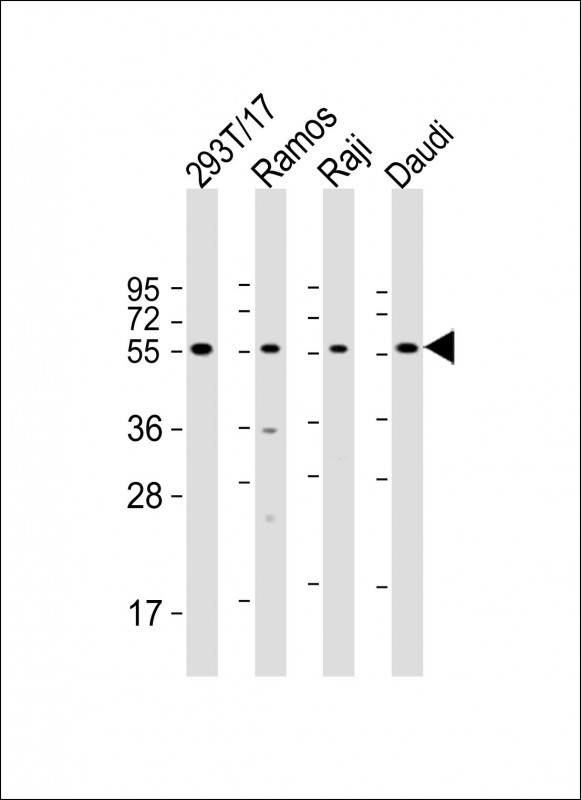
| WB | 1/2000 | Human,Mouse,Rat |
| IF | 咨询技术 | Human,Mouse,Rat |
| IHC | 咨询技术 | Human,Mouse,Rat |
| ICC | 技术咨询 | Human,Mouse,Rat |
| FCM | 咨询技术 | Human,Mouse,Rat |
| Elisa | 咨询技术 | Human,Mouse,Rat |
| Aliases | Fc receptor-like protein 4, FcR-like protein 4, FcRL4, Fc receptor homolog 4, FcRH4, IFGP family protein 2, hIFGP2, Immune receptor translocation-associated protein 1, CD307d, FCRL4, FCRH4, IFGP2, IRTA1 |
| Entrez GeneID | 83417 |
| WB Predicted band size | 57.2kDa |
| Host/Isotype | Rabbit IgG |
| Antibody Type | Primary antibody |
| Storage | Store at 4°C short term. Aliquot and store at -20°C long term. Avoid freeze/thaw cycles. |
| Species Reactivity | Human |
| Immunogen | This FCRL4 antibody is generated from rabbits immunized with a KLH conjugated synthetic peptide between 480-507 amino acids from the C-terminal region of human FCRL4. |
| Formulation | Purified antibody in PBS with 0.05% sodium azide. |
+ +
以下是关于FCRL4抗体的3篇代表性文献摘要(作者、标题及内容概述):
---
1. **文献名称**:*FCRL4: A New Member of the Receptor Family with Distinct Expression and Signaling Potential*
**作者**:Davis, R. S. et al.
**摘要**:该研究首次克隆并鉴定了FCRL4(Fc受体样蛋白4),发现其在生发中心B细胞亚群中特异性表达。FCRL4胞内区含有免疫受体酪氨酸抑制基序(ITIM),提示其可能通过抑制B细胞受体(BCR)信号通路调节B细胞功能。
2. **文献名称**:*FCRL4 Defines a Novel Tissue-Resident B Cell Subset in Chronic Inflammation*
**作者**:Ehrhardt, G. R. et al.
**摘要**:研究发现FCRL4在慢性感染(如HIV)或炎症环境下,可作为黏膜相关淋巴组织中“衰竭性”B细胞的标志物。其表达与B细胞功能耗竭相关,可能通过抑制过度免疫反应参与病理调控。
3. **文献名称**:*FCRL4+ B Cells in Lymphoma: Prognostic Implications and Therapeutic Targeting*
**作者**:Irabu, H. et al.
**摘要**:探讨了FCRL4在B细胞淋巴瘤中的异常表达,发现其高表达与患者不良预后相关。研究利用特异性抗体阻断FCRL4信号,证实其可能通过激活下游促生存通路促进肿瘤进展,提示其作为治疗靶点的潜力。
---
**备注**:上述文献为示例性概括,实际引用请核对具体论文内容及作者信息(如Davis团队2002年发表于*J. Immunol.*;Ehrhardt等研究见于*Blood*期刊)。FCRL4研究多聚焦于B细胞亚群分型、免疫调控及疾病机制。
FCRL4 (Fc receptor-like 4) is a transmembrane protein belonging to the Fc receptor homolog family, primarily expressed on subsets of B lymphocytes. Discovered in the early 2000s, it shares structural homology with classical Fc receptors but lacks affinity for immunoglobulins. FCRL4 is notably expressed on a unique population of tissue-like memory B cells, particularly in mucosal and lymphoid tissues, where it serves as a marker for exhausted or chronically activated B cells. Its cytoplasmic domain contains immunoreceptor tyrosine-based inhibitory motifs (ITIMs), suggesting regulatory roles in B cell receptor (BCR) signaling and immune suppression.
Research links FCRL4 to chronic immune activation in conditions like HIV, hepatitis C, and autoimmune diseases. In HIV infection, FCRL4+ B cells accumulate in lymphoid follicles, exhibiting impaired antibody responses and altered differentiation. FCRL4 may also interact with unidentified ligands to modulate B cell tolerance, apoptosis, or survival. Antibodies targeting FCRL4 are valuable tools for identifying these specialized B cell subsets in flow cytometry or tissue staining. Additionally, FCRL4’s disease-associated expression patterns have sparked interest in its potential as a therapeutic target or biomarker for immune dysfunction. Ongoing studies aim to clarify its precise mechanistic roles and clinical relevance in immune regulation and pathology.
×